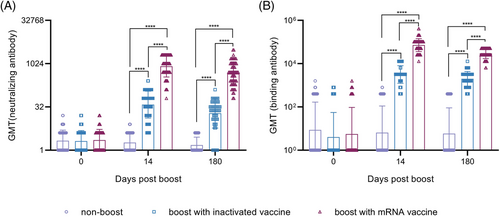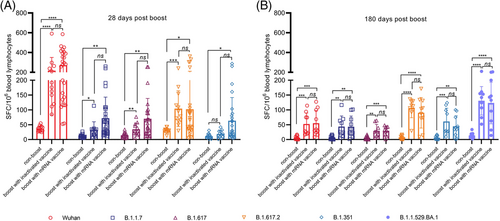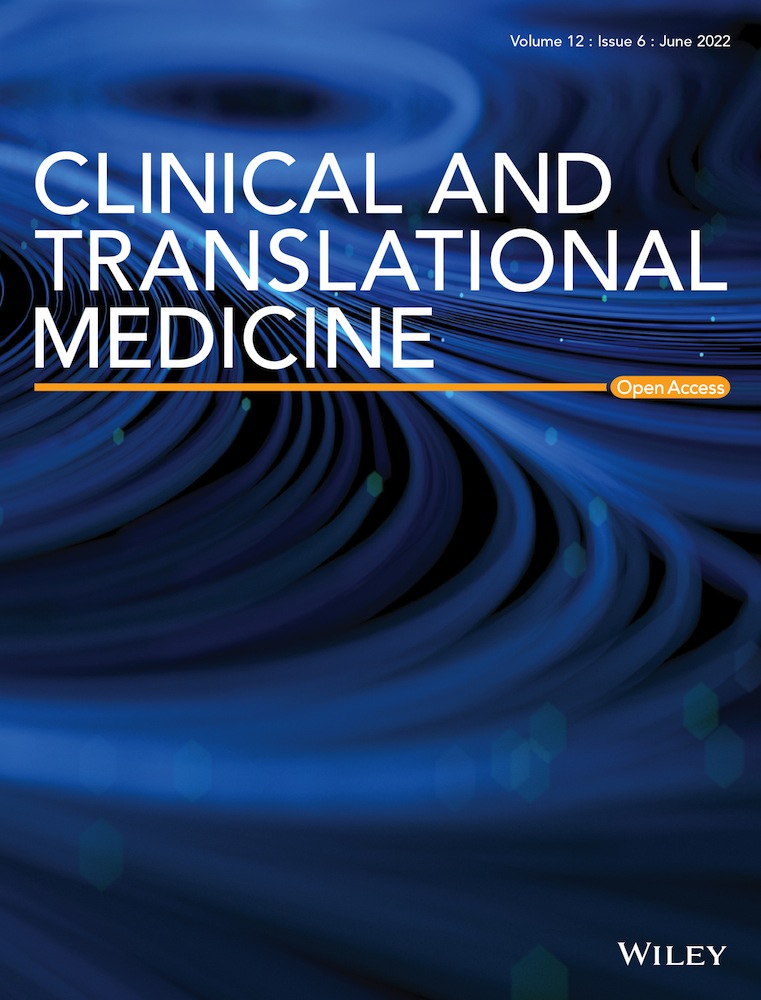Immunological evaluation of an mRNA vaccine booster in individuals fully immunized with an inactivated SARS-CoV-2 vaccine
Dear Editor,
More than 5.75 million deaths and 396.55 million cases of coronavirus disease 2019 (COVID-19) have been reported, including those caused by at least five variants of severe acute respiratory syndrome coronavirus 2 (SARS-CoV-2).1 This situation has caused public concern about the effectiveness of immune responses to emerging variants elicited by boosters of different vaccines in previously immunized populations.2, 3 Our study, based on a cohort immunized with two doses of the inactivated vaccine and boosted with the messenger RNA (mRNA) vaccine at an interval of 6 months, investigates immunity of heterologous vaccination. The inactivated and mRNA vaccines used in this study were developed based upon the sequence of the Wuhan strain.4, 5 In total, 288 healthy adult volunteers were immunized with an inactivated vaccine (150 U/dose) at an interval of 14 days; neutralizing antibodies were identified as having a geometric mean titer (GMT) of 2.1 and as negative in 52% of this population at 6 months after full immunization. Among them, 118 and 97 immunized subjects were boosted with the inactivated (150 U/dose) or mRNA (25 μg/dose) vaccine, and 73 immunized subjects were monitored as non-boosted controls. The average ages of the three groups were 43.04 ± 13.05, 31.86 ± 7.62 and 30.05 ± 7.03 years, respectively (Table S1). Immunological observation was until day 180 post-boost, which was available for 60, 61 and 68 subjects in the inactivated vaccine boost, mRNA vaccine boost and nonboosted groups, respectively (Figure S1). Antibody assays performed at days 14 and 180 post-boost showed GMTs of 829 and 455 on days 14 and 180, respectively, against the Wuhan strain in the mRNA boost group, in comparison to GMTs of 39 and 19, respectively, in the inactivated vaccine boost group (Figure 1). Binding antibody titers reached 71864 and 29675 and 3162 and 1993 on days 14 and 180, respectively, in the mRNA and inactivated vaccine boost groups (Figure 1). Further cross-neutralization for the B.1.617.2 and B.1.1.529 strains suggested that sera from the mRNA vaccine boost group possess a strong neutralizing antibody titer against the B.1.617.2 strain, with GMTs reaching 540 and 335 at days 14 and 180 post-boost, respectively. The data are close to those against the Wuhan strain; sera showed GMTs of 108 and 33 against the B.1.1.529 strain at the same times (Figure 2). Analysis of dynamic variation of these neutralizing antibodies against variants in 17 subjects from the three groups suggested that non-boosted individuals displayed a continuous decline in neutralizing antibodies during the study to titers of 1 (Figure 3) and that the inactivated vaccine- and mRNA vaccine-boosted groups presented a tendency to decline from high levels (Figure 3). However, there was distinct differential variation in the neutralizing antibody titer in the inactivated vaccine-boosted and mRNA vaccine-boosted groups. The antibody titer in individuals boosted by the mRNA vaccine showed only a slight decline and even remained stable in one individual (Figure 3), whereas the titer variation among those boosted by the inactivated vaccine presented the same slope as those of the non-boosted group. Importantly, these tendencies were similar among antibodies against the Wuhan, B.1.617.2 and B.1.1.529 strains (Figure 3). These data highlight a possible vaccine strategy that might achieve an increased antibody response against current variants in inactivated vaccine-immunized individuals with mRNA vaccine booster immunization that might be capable of maintaining effective immunity for at least 6 months, enhancing confidence in the defence against the COVID-19 pandemic, even though the immunological mechanism underlying this phenomenon is currently unclear.



The S protein-specific T cell response assay using viral receptor-binding domain (RBD) peptides with specific mutations identified in the B.1.1.7, B.1.617, B.1.617.2, B.1.351, B.1.1.529.BA.1 and Wuhan strains suggest higher spot numbers for the wild-type RBD of the S protein than for the RBDs derived from the variants at day 28 post-boost in individuals boosted with the mRNA vaccine (Figure 4A). However, spot counting in the assay at day 180 post-boost indicated similar effective T cell responses against the RBD peptide with the mutations of B.1.1.529.BA.1 in comparison to those against RBD peptides with characterized mutations of previous variants (Figure 4B). These results suggest that activated immune memory is definite in individuals primarily immunized with an inactivated vaccine and boosted with an mRNA vaccine. According to clinical monitoring for 28 days after boosting, mild (grade 1) to moderate (grade 2) pain, redness, swelling and pruritus at the injection site were reported as the main local adverse events over 7 days. Approximately 26 subjects reported severe pain (Table S2). Transient fatigue was the most common systemic event, with 21% of the participants in this group reporting this adverse event. Nine subjects reported transient fever (grade 2) with general weakness or headache. The incidence rate of adverse reactions in the mRNA group was obviously lower than the rates reported in clinical studies of other mRNA vaccines.6

Clinical trials of inactivated vaccines report antigen-specific humoural and cellular immune responses and protective efficacy against pandemics caused by the Wuhan strain.7, 8 However, subsequent studies on the duration of immunity elicited by the vaccine against the Wuhan strain and other variants indicate dramatic declines in neutralizing and binding antibody titers, suggesting that a booster vaccination is needed to maintain neutralizing antibodies in this vaccinated population.9 In this study, a dose of 25 μg of mRNA vaccine as a clinical-stage product was used for booster immunization in individuals previously immunized with an inactivated vaccine, eliciting robust enhancement of antigen-specific antibody titers and cellular immune responses, which is similar to the data that heterologous boosting is associated with more robust immune responses than homologous boosting.10 Indeed, they were substantially greater than those achieved with booster immunization with the inactivated vaccine in our previous work and, importantly, also exhibited cross-reactivity with an antigen carrying the mutations of the delta and omicron variants, showing not only positive specific effective T cell responses against S antigens with various mutations but also high neutralizing antibody titers against the B.1.617.2 and B.1.1.529 and Wuhan strains.
In conclusion, all of these data support the conclusion that boosting previously inactivated vaccine-immunized individuals with an mRNA vaccine is a promising strategy for increasing population-level immunity against the rising pandemic caused by variants.
ACKNOWLEDGEMENTS
The authors thank Jeffrey Ulmer for critical readings and editing of the manuscript. This work was supported by the National Key R&D Program of China (grant numbers: 2020YFC0849700 and 2020YFC0860600), the Major Science and Technology Special Projects of Yunnan Province (grant numbers: 202003AC100003, 202003AC100009, 202101AS070053 and 202102AA310043) and the Program of Chinese Academy of Medicine Sciences (grant numbers: 2020HY320001 and 2020-I2M-2-014).
CONFLICT OF INTEREST
The authors declare no competing interests.




